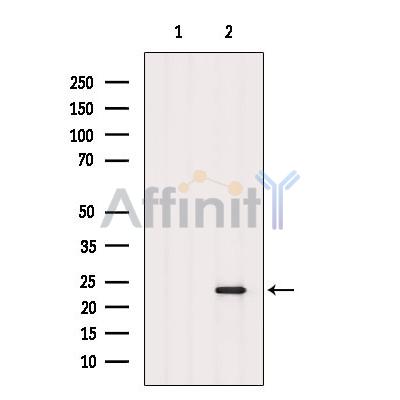RAB8A Antibody - #DF9836
| 製品: | RAB8A Antibody |
| カタログ: | DF9836 |
| タンパク質の説明: | Rabbit polyclonal antibody to RAB8A |
| アプリケーション: | WB |
| 反応性: | Human, Mouse, Rat, Monkey |
| 予測: | Pig, Zebrafish, Bovine, Horse, Sheep, Dog, Chicken, Xenopus |
| 分子量: | 24 kDa; 24kD(Calculated). |
| ユニプロット: | P61006 |
| RRID: | AB_2843030 |
製品説明
*The optimal dilutions should be determined by the end user.
*Tips:
WB: For western blot detection of denatured protein samples. IHC: For immunohistochemical detection of paraffin sections (IHC-p) or frozen sections (IHC-f) of tissue samples. IF/ICC: For immunofluorescence detection of cell samples. ELISA(peptide): For ELISA detection of antigenic peptide.
引用形式: Affinity Biosciences Cat# DF9836, RRID:AB_2843030.
折りたたみ/展開
AA409338; MEL; Mel transforming oncogene (derived from cell line NK14) RAB8 homolog; Mel transforming oncogene (derived from cell line NK14); Mel transforming oncogene (RAB8 homolog); Mel transforming oncogene; MGC124948; Oncogene c mel; Oncogene c-mel; RAB8; RAB8A; RAB8A member RAS oncogene family; RAB8A_HUMAN; Ras associated protein RAB8; Ras related protein Rab 8A; Ras-related protein Rab-8A;
免疫原
A synthesized peptide derived from human RAB8A, corresponding to a region within C-terminal amino acids.
- P61006 RAB8A_HUMAN:
- Protein BLAST With
- NCBI/
- ExPASy/
- Uniprot
MAKTYDYLFKLLLIGDSGVGKTCVLFRFSEDAFNSTFISTIGIDFKIRTIELDGKRIKLQIWDTAGQERFRTITTAYYRGAMGIMLVYDITNEKSFDNIRNWIRNIEEHASADVEKMILGNKCDVNDKRQVSKERGEKLALDYGIKFMETSAKANINVENAFFTLARDIKAKMDKKLEGNSPQGSNQGVKITPDQQKRSSFFRCVLL
種類予測
Score>80(red) has high confidence and is suggested to be used for WB detection. *The prediction model is mainly based on the alignment of immunogen sequences, the results are for reference only, not as the basis of quality assurance.
High(score>80) Medium(80>score>50) Low(score<50) No confidence
研究背景
The small GTPases Rab are key regulators of intracellular membrane trafficking, from the formation of transport vesicles to their fusion with membranes. Rabs cycle between an inactive GDP-bound form and an active GTP-bound form that is able to recruit to membranes different sets of downstream effectors directly responsible for vesicle formation, movement, tethering and fusion. That Rab is involved in polarized vesicular trafficking and neurotransmitter release. Together with RAB11A, RAB3IP, the exocyst complex, PARD3, PRKCI, ANXA2, CDC42 and DNMBP promotes transcytosis of PODXL to the apical membrane initiation sites (AMIS), apical surface formation and lumenogenesis. Together with MYO5B and RAB11A participates in epithelial cell polarization. May be involved in ciliogenesis. Together with MICALL2, may also regulate adherens junction assembly (By similarity). May play a role in insulin-induced transport to the plasma membrane of the glucose transporter GLUT4 and therefore play a role in glucose homeostasis (By similarity). Involved in autophagy.
Phosphorylation of Thr-72 in the switch II region by LRRK2 prevents the association of RAB regulatory proteins, including CHM, CHML and RAB GDP dissociation inhibitors GDI1 and GDI2.
Cell membrane>Lipid-anchor>Cytoplasmic side. Golgi apparatus. Recycling endosome membrane. Cell projection>Cilium. Cytoplasmic vesicle>Phagosome. Cytoplasmic vesicle>Phagosome membrane>Lipid-anchor>Cytoplasmic side. Cytoplasm>Cytoskeleton>Microtubule organizing center>Centrosome>Centriole. Cytoplasm>Cytoskeleton>Cilium basal body. Midbody. Cytoplasm. Cytoplasm>Cytoskeleton>Cilium axoneme.
Note: Colocalizes with OPTN at the Golgi complex and in vesicular structures close to the plasma membrane (PubMed:15837803). In the GDP-bound form, present in the perinuclear region (PubMed:12221131). Shows a polarized distribution to distal regions of cell protrusions in the GTP-bound form (PubMed:12221131). Colocalizes with PARD3, PRKCI, EXOC5, OCLN, PODXL and RAB11A in apical membrane initiation sites (AMIS) during the generation of apical surface and lumenogenesis (PubMed:20890297). Localizes to tubular recycling endosome (PubMed:19864458). Recruited to phagosomes containing S.aureus or M.tuberculosis (PubMed:21255211). Non-phosphorylated RAB8A predominantly localizes to the cytoplasm whereas phosphorylated RAB8A localizes to the membrane (PubMed:26824392, PubMed:29125462, PubMed:30398148).
Belongs to the small GTPase superfamily. Rab family.
研究領域
· Cellular Processes > Transport and catabolism > Endocytosis. (View pathway)
· Cellular Processes > Cellular community - eukaryotes > Tight junction. (View pathway)
· Environmental Information Processing > Signal transduction > AMPK signaling pathway. (View pathway)
· Organismal Systems > Digestive system > Pancreatic secretion.
Restrictive clause
Affinity Biosciences tests all products strictly. Citations are provided as a resource for additional applications that have not been validated by Affinity Biosciences. Please choose the appropriate format for each application and consult Materials and Methods sections for additional details about the use of any product in these publications.
For Research Use Only.
Not for use in diagnostic or therapeutic procedures. Not for resale. Not for distribution without written consent. Affinity Biosciences will not be held responsible for patent infringement or other violations that may occur with the use of our products. Affinity Biosciences, Affinity Biosciences Logo and all other trademarks are the property of Affinity Biosciences LTD.
